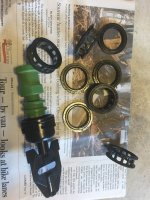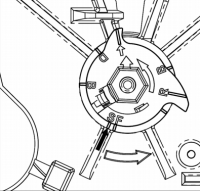artx
New Member
Hi - new posting to the forum but I've found a lot of helpful info here before. I could use some assistance on my water softener - has a Fleck 7000 valve. 10 years old. 80psi street water pressure.
The problem is intermittent low water pressure when performing high draw tasks- filling tub, shower, washing machine. Pressure on the softener output drops to <20psi and water slows to a trickle. If you turn all water consumption in the house off and wait a while, it resets to normal pressure. I've verified the street pressure stays at 80psi during these modes, and that bypassing the softener fixes the issue immediately. I also make sure the brine valve is set to service correctly when this happens. I've tried performing regenerations with no change.
Following one of the Fleck 7000 rebuild videos posted on this site, I took apart the valve today hoping to find something obviously broken. The injector either broke on extraction or was already broken into two peices. Other than that it looked ok. I took out the turbine as well. Looked ok.
I used to have a pressure reduction valve ahead of the softener that reduced the pressure to 60psi. I pulled it out thinking it was the culprit with no changes. Valve was necessary before the city replaced my meter with a meter containing a pressure reduction valve.
I'm on standard city water.
Any suggestions? Would a rebuild be likely to fix this kind of problem? I don't want to spend the $ on a rebuild without a decent chance of success. Appreciate any help.
The problem is intermittent low water pressure when performing high draw tasks- filling tub, shower, washing machine. Pressure on the softener output drops to <20psi and water slows to a trickle. If you turn all water consumption in the house off and wait a while, it resets to normal pressure. I've verified the street pressure stays at 80psi during these modes, and that bypassing the softener fixes the issue immediately. I also make sure the brine valve is set to service correctly when this happens. I've tried performing regenerations with no change.
Following one of the Fleck 7000 rebuild videos posted on this site, I took apart the valve today hoping to find something obviously broken. The injector either broke on extraction or was already broken into two peices. Other than that it looked ok. I took out the turbine as well. Looked ok.
I used to have a pressure reduction valve ahead of the softener that reduced the pressure to 60psi. I pulled it out thinking it was the culprit with no changes. Valve was necessary before the city replaced my meter with a meter containing a pressure reduction valve.
I'm on standard city water.
Any suggestions? Would a rebuild be likely to fix this kind of problem? I don't want to spend the $ on a rebuild without a decent chance of success. Appreciate any help.


